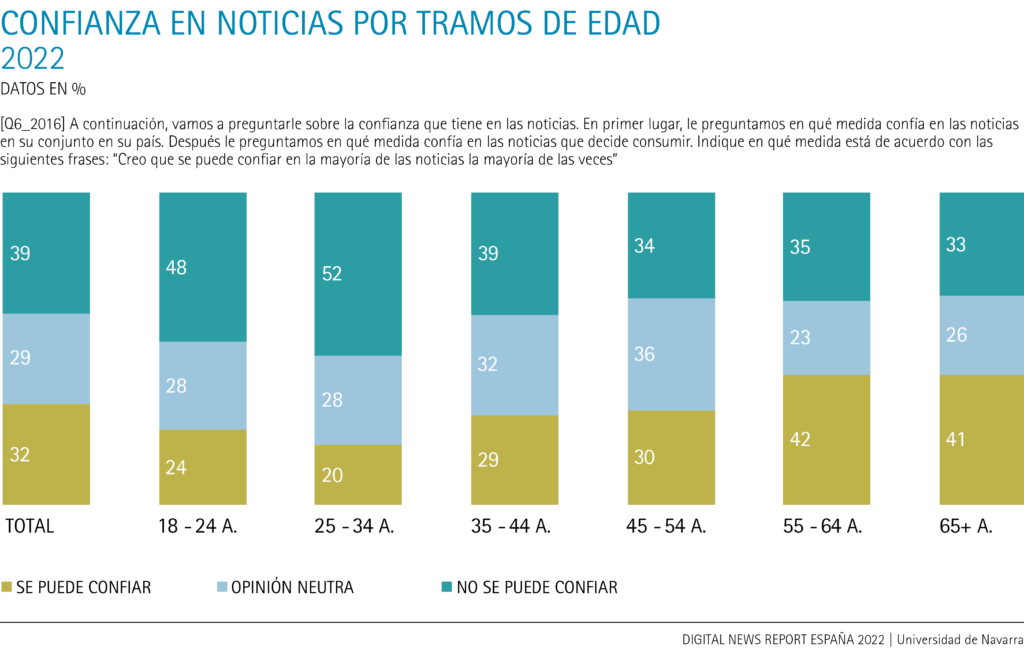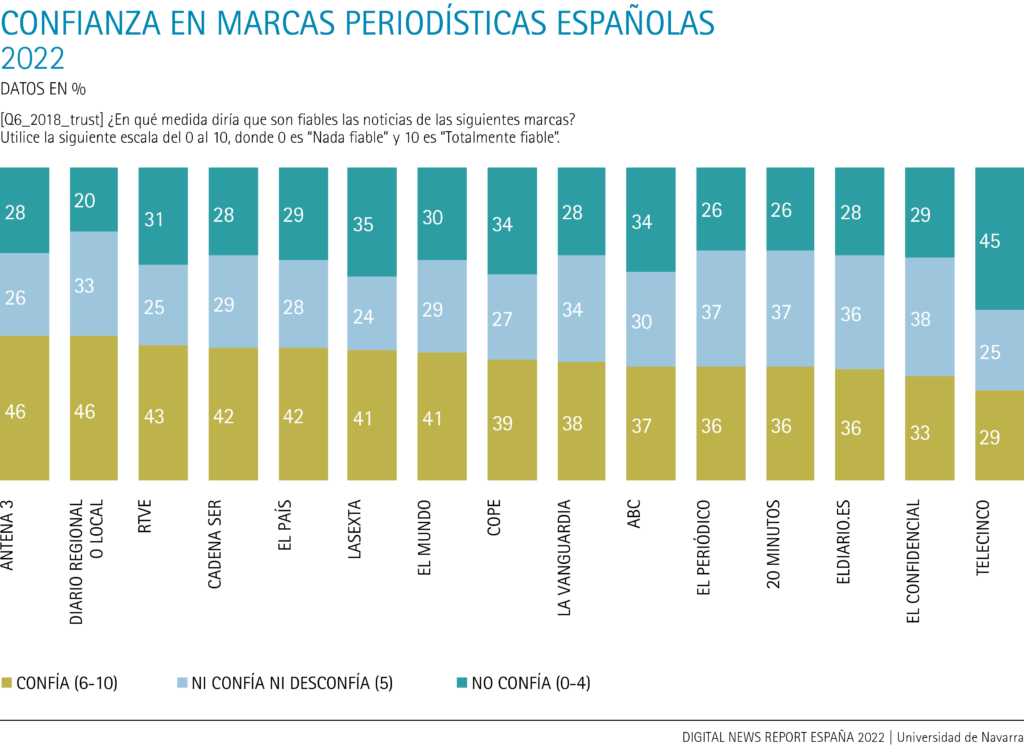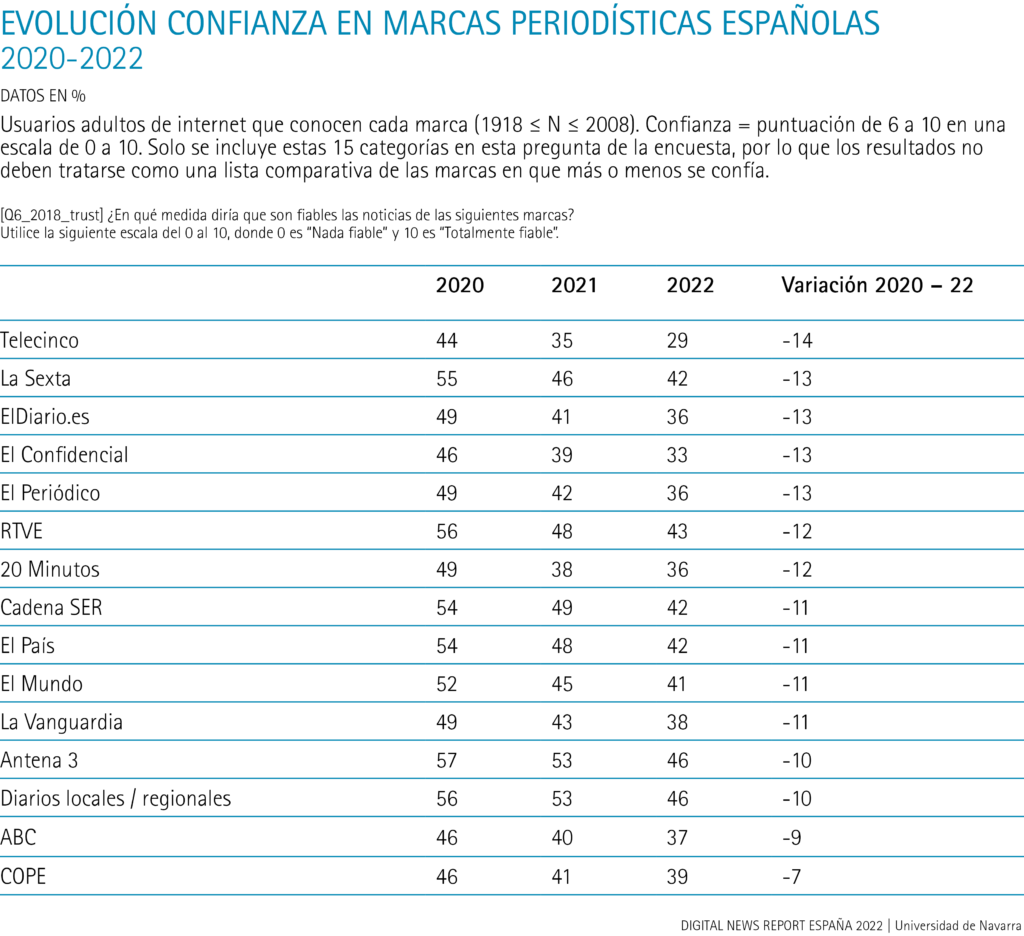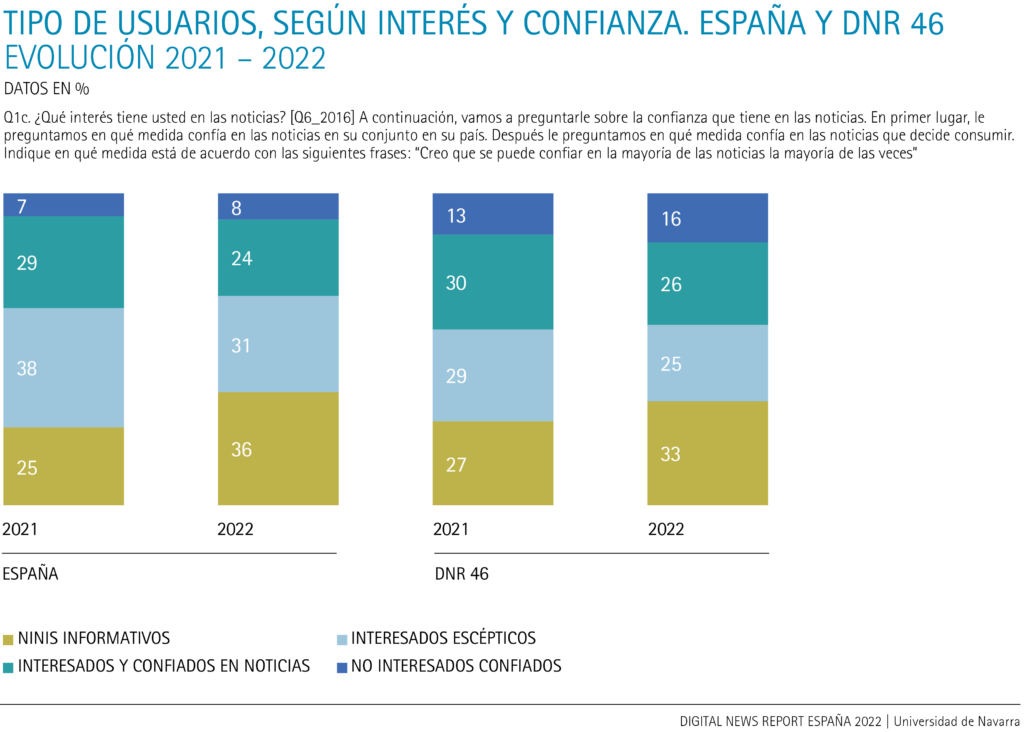-
The credibility of the main Spanish journalistic brands has worsened considerably.
-
One out of every three Spaniards has no interest in or trust in the news (36%).
The loss of confidence of Spanish users in the news is worsening and, for the first time since the Digital News Report España reports have been published, the percentage of those who do not trust the news (39%) exceeds that of those who usually do (32%). The slight recovery in credibility observed last year was a mirage and data for 2022 shows a very worrying panorama for Spanish news companies. The loss of credit has been continuous since 2017, a year in which more than half of the respondents declared to trust the media (51%) and only 24% were skeptical about the news.

The data are even more worrying when compared to the other 45 countries included in the study. In total, 42% of respondents trust the media compared to 27% who do not. In detail, Spain is among the ten countries with the lowest credibility in the news, behind only the USA (26% trust), Slovakia (26%), Greece (27%), Taiwan (27%), France (29%) and the Republic of Korea (30%). And one more fact: Spain is one of the five countries in which the percentage of distrustful people exceeds the percentage of those who trust the news.

The analysis of trust in news by age group sample shows two well-defined trends in Spain. On the one hand, the traditional distrust among younger users is worsening; more than half (51%) of those under 35 years of age do not trust the news, compared to 21% who do. Secondly, skepticism is spreading among more advanced age groups, who until this year had declared themselves to be mostly trusting of the news. Thus, among respondents aged 45 to 54, confidence has plummeted nine percentage points and there is now a majority of those who do not trust the news (34%) compared to those who do (30%).

Nevertheless, and as in previous reports, it is important to qualify data in relation to news trust. In addition to asking about the credibility of news in general, respondents are asked about the credibility of specific news items they consume. In this case, the trust that citizens have in 'their' news is greater than that declared in news 'in general': 38% of Spanish Internet users trust 'their' news, compared to 31% who distrust it. These data are the confirmation of the so-called 'third person effect', an unconscious bias of people that tends to underestimate the negative effect that the media can cause on oneself, by which they think that their media deserve more trust than those used by the rest of the citizens. Unfortunately, the data show that this trust in the news itself has not been immune to the generalized loss of news credibility, falling 4 points with respect to 2021.

Credibility of journalistic brands
In addition to trust in the general news and in the news that each respondent declares to consume, order has once again asked the participants in the study to rate the trust they have in some of the main Spanish news brands. It is important to note that the survey does not ask about all brands, but only about a sample of 14, and therefore the results cannot be interpreted as a ranking of the credibility of Spanish news brands.
The 2022 data consolidates two trends that have been observed over the past few years. First, respondents report having more trust in specific brands than in news in general or even in the news they consume. In this sense, Antena 3 and regional/local newspapers repeat as the most valued by Spanish users who know them (46% trust them). Secondly, the credibility of the brands analyzed has been weakening over the years and, for the first time since this question has been asked, no journalistic brand analyzed enjoys the trust of more than 50% of those surveyed and all of them have lost credit in the last year. Looking back, in 2020, 51% of respondents trusted brands; two years later, that average has fallen by more than 11 percentage points to 39%.

The analysis by brands sample shows that the loss of trust has been especially intense in Telecinco (from 43.6% of respondents who trusted its news in 2020, it has gone to 29.2% in 2022). In fact, it is the only journalistic brand analyzed that generates more distrust (45.4% do not trust) than trust (29.2%) among Spanish users. But the rest of the brands analyzed have not been immune to the loss of credibility, particularly acute in the cases of La Sexta, Eldiario.es, El Confidencial, El Periódico de Catalunya, RTVE and 20 Minutos.

Worrying increase in the number of disinterested and distrustful citizens
In addition to the decline in trust in the news, and as described in more depth in the following chapter, the data of this year's survey reflects a worrying drop in citizens' interest in information. This double decline is clearly reflected in the evolution of the four groups into which we classify the majority of Spanish users based on both variables.
According to this year's data , the largest group is made up of the so-called 'news ninis', i.e. those who neither trust nor are interested in the news. They account for 36% of respondents, eleven percentage points more than last year. They are followed by the group of the 'skeptical stakeholders', i.e. those who have interest in the news, but little or no trust in them (31%, seven percentage points less than in 2021). The group of those who are interested and confident in the news has also dropped, from 29% in 2021 to 24% this year. Finally, the group of the 'disinterested confident' has barely changed in the last year, from 7% to 9%.
The analysis of data reveals that in the last year there has been a significant shift from group of skeptical stakeholders (-7.2 percentage points) and confident stakeholders (-5.2 pp) to disinterested and distrustful stakeholders (+11.3 pp), as a consequence of the joint effect of loss of confidence and disinterest in the news.

As can be seen in the graph above, the increase in disinterested and distrustful people is not exclusive to Spain. It is a global phenomenon that has occurred in most of the countries analyzed, whose average number of disinterested and distrustful 'ninis' has also increased significantly to 33%, six percentage points higher than last year. As in Spain, this is the largest group , ahead of interested and confident (27%) and interested skeptics (25%). However, the figures for Spain, although slightly higher than the average, are far from European countries such as the Slovak Republic (55%), France (47%) or Italy (45%). At the other extreme, Finland (14%), Norway (23%), Portugal (24%) and Denmark (25%) are the European countries with the lowest percentages of disinterested and distrustful people.